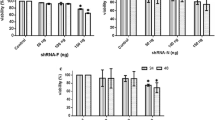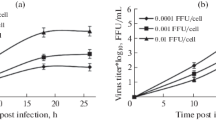Abstract
Influenza A virus genome segment 7 encodes protein M1, which is the matrix protein playing crucial role in the virus life cycle. Any antiviral strategy that aims at reducing, in particular, the expression of this genome segment should, in principle, reduce the infectivity of the virus. We developed a specific antiviral approach at the molecular level and designed several novel 10–23 DNAzymes (Dz) and hammerhead ribozymes (Rz), specifically targeted to cleave at the conserved domains of the influenza virus M1 RNA. We sought to use antisense molecules with the hope that it will facilitate the ribozyme-mediated cleavage. We observed that the Mg2+-dependent sequence-specific cleavage of M1 RNA was achieved by both the Dz and Rz in a dose-dependent manner. This combination of catalytic Dz and Rz with antisense molecules, in principle, resulted in more effective gene suppression, inhibited the whole virus replication in host cell, and thus could be exploited for therapeutic purposes.









Similar content being viewed by others
Abbreviations
- Dz:
-
DNAzymes
- Rz:
-
Ribozymes
- AS:
-
Antisense
References
Khanna, M., Kumar, P., Choudhary, K., Kumar, B., & Vijayan, V. K. (2008). Emerging influenza virus: A global threat. Journal of Biosciences, 33, 475–482.
Akkina, R., Banerjea, A., Bai, J., Anderson, J., Li, M. J., & Rossi, J. J. (2003). si-RNAs, ribozymes and RNA decoys in modeling stem cell based gene therapy for HIV/AIDS. Anticancer Research, 23, 1997–2005.
Santoro, S. W., & Joyce, G. F. (1997). General purpose RNA-cleaving DNA enzyme. Proceedings of the National Academy of Sciences of the United States of America, 94, 4262–4266.
Banerjea, A. C., Chakraborti, S., Unwalla, H., Goila, R., Shrabani, S., Dash, B. C., et al. (2004). Potential therapeutic applications of DNA-enzymes and siRNAs against viral and cellular genes. In L. M. Khachigian (Ed.), Synthetic nucleic acids as inhibitors of gene expression: Mechanisms, applications, and therapeutic implications (pp. 115–134). Florida: CRC Press.
Kumar, P., Sood, V., Vyas, R., Gupta, N., Banerjea, A. C., & Khanna, M. (2010). Potent inhibition of influenza virus replication with novel siRNA-chimeric-ribozyme constructs. Antiviral Research, 87(2), 204–212.
Joyce, G. F. (2004). Directed evolution of nucleic acid enzymes. Annual Review of Biochemistry, 73, 791–836.
Dash, B. C., & Banerjea, A. C. (2004). Sequence specific cleavage activities of DNA-enzymes targeted against HIV-1 Gag and Nef regions. Oligonucleotides, 14, 41–47.
Sood, V., Gupta, N., Bano, A. S., & Banerjea, A. A. (2007). DNA-enzyme-mediated cleavage of human immunodeficiency virus type 1 Gag RNA is significantly augmented by antisense-DNA molecules targeted to hybridize close to the cleavage site. Oligonucleotides, 17, 113–121.
Chen, C. J., Banerjea, A. C., Harmison, G. G., Haglund, K., & Schubert, M. (1992). Multitarget-ribozyme directed to cleave at up to nine highly conserved HIV-1 env RNA regions inhibits HIV-1 replication—Potential effectiveness against most presently sequenced HIV-1 isolates. Nucleic Acids Research, 20, 4581–4589.
Lazarev, V. N., Shmarov, M. M., Zakhartchouk, A. N., Yurov, G. K., Misurina, O. U., Akopian, T. A., et al. (1999). Inhibition of influenza A virus reproduction by a ribozyme targeted against PB1 mRNA. Antiviral Research, 42, 47–57.
Tang, X., Hobom, G., & Luo, D. (1994). Ribozyme mediated destruction of influenza A virus in vitro and in vivo. Journal of Medical Virology, 42, 385–395.
Hoffman, E., et al. (2001). Universal primer set for the full-length amplification of all influenza A viruses. Archives of Virology, 146(12), 2275–2289.
Shahi, S., Shanmugasundram, G. K., & Banerjea, A. C. (2001). Ribozymes that cleave reovirus genome S1 also protects cells from pathogenesis caused by reovirus infection. Proceedings of the National Academy of Sciences of the United States of America, 98, 4101–4106.
Banerjea, A. C., & Joklik, W. K. (1990). Reovirus protein sigma 1 translated in vitro, as well as truncated derivatives of it that lack up to two-thirds of its C-terminal portion, exists as two major tetrameric molecular species that differ in electrophoretic mobility. Virology, 179, 460–462.
Wang, Y. G., et al. (2002). A general approach for the use of oligonucleotide effectors to regulate the catalysis of RNA-cleaving ribozymes and DNAenzymes. Nucleic Acid Research, 30(8), 1735–1742.
Tompkins, S. M., Lo, C. Y., Tumpey, T. M., & Epstein, S. L. (2004). Protection against lethal influenza virus challenge by RNA interference in vivo. Proceedings of the National Academy of Sciences of the United States of America, 101, 8682–8686.
Sun, L. Q., Wang, L., Gerlach, W. L., & Symonds, G. (1995). Target sequence-specific inhibition of HIV-1 replication by ribozymes directed to tat RNA. Nucleic Acids Research, 23, 2909–2913.
Campbell, T. B., Mcdonald, C. K., & Hagen, M. (1997). The effect of structure in a long target RNA on ribozyme cleavage efficiency. Nucleic Acids Research, 25, 4985–4993.
Gaugham, D. J., Steel, D. M., & Whitehead, S. A. (1995). Ribozyme mediated cleavage of acute phase serum amyloid A (A-SAA) mRNA in vitro. FEBS Letter, 374, 241–245.
Acknowledgments
The authors thankfully acknowledges the financial support provided by Department of Biotechnology, Government of India.
Author information
Authors and Affiliations
Corresponding author
Rights and permissions
About this article
Cite this article
Kumar, B., Khanna, M., Kumar, P. et al. Nucleic Acid-Mediated Cleavage of M1 Gene of Influenza A Virus Is Significantly Augmented by Antisense Molecules Targeted to Hybridize Close to the Cleavage Site. Mol Biotechnol 51, 27–36 (2012). https://doi.org/10.1007/s12033-011-9437-z
Published:
Issue Date:
DOI: https://doi.org/10.1007/s12033-011-9437-z




